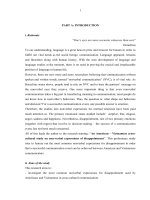An american – vietnamese cross-cultural study on non-verbal expressions of disappointment part 3
Bạn đang xem bản rút gọn của tài liệu. Xem và tải ngay bản đầy đủ của tài liệu tại đây (103.3 KB, 7 trang )
CERTIFICATE OF ORIGINALITY OF STUDY PROJECT REPORT
I HEREBY CERTIFY THAT THE STUDY PROJECT REPORT SUBMITTED
ENTITLED
AN AMERICAN - VIETNAMESE CROSS-CULTURAL STUDY ON NONVERBAL
EXPRESSIONS OF DISAPPOINTMENT
IS MY OWN STUDY IN THE FULFILLMENT OF THE REQUIREMENTS FOR THE
DEGREE OF MASTER OF ARTS.
Ha Noi, 2009
Bùi Hải Sơn
i
Acknowledgements
I would like to take this opportunity to thank all the following people for their great
supports during my three-year time for the MA course.
First and foremost, I would like to express my deep gratitude to Ms. Phan Thị Vân
Quyên, my supervisor, for her clear guidance, insightful comments and dutiful supervision.
I would like to give my sincere thanks to all the lecturers at University of Languages
and International Studies, Vietnam National University - Ha Noi (HULIS-VNU) for their
knowledge, experience and enthusiasm in their lectures, from which I have acquired valuable
knowledge and inspiration to fulfill this minor thesis.
My deep thanks also go to Assoc. Prof. Dr. Nguyễn Quang whose interesting lectures
on Cross-Cultural Communication with perspectives on cultural variety have inspired me to
do this cross- cultural study.
I would like to express my gratitude to my family, to many of my friends and
colleagues, for their valuable sharing and encouragements.
I wish to acknowledge the important contribution of both Vietnamese and American
informants, whose names I cannot mention here for the completion of my study.
ii
AN AMERICAN – VIETNAMESE CROSS-CULTURAL STUDY
ON NONVERBAL EXPRESSIONS OF DISAPPOINTMENT
ABSTRACT
The purpose of this study was to investigate the most common nonverbal expressions of
disappointment used by American and Vietnamese people in the field of facial expressions,
gestures and postures. Another aim was to find out the similarities and differences between
their ways of expressions. Finally, the influential factors affecting the expressions of
disappointment were also examined in the study.
The quantitative method was applied in the research. The survey inspected American
nonverbal expressions of disappointment through Vietnamese informants’ perception and
Vietnamese nonverbal ways of expressing disappointment through American informants’
observation. 30 questionnaires were sent out and 30 responses were received.
One result of the study was that disappointment seemed to be a universal emotion of which
American and Vietnamese people shared most the expressions. It was also discovered that
the informants’ length of stay or work with native people and cultural knowledge had great
influence on their perception of communicating partners’ emotional states. Additionally, the
results of the study revealed that the choice of expressing disappointment depended much on
the communicating partners and communicating situations.
The principal conclusion was that people would communicate better when understanding
more about the host culture. One different conclusion was that the successful cross-cultural
communication did not only depend on length of stay or work with people of another culture.
iii
TABLE OF ABBREVIATIONS
NVC: Nonverbal Communication
ELT: English Language Teaching
CE: Communication Event
CA: Communication Act
VN: Vietnam/ Vietnamese
AM: America/American
iv
List of tables
Table 1: Informants’ parameters
Table 2: American and Vietnamese common expressions of disappointment
Table 3: Amount of expressiveness in American and Vietnamese cultures
Table 4: Amount of expressiveness as seen from informants' length of stay
Table 5: Amount of expressiveness as seen from the informants' cultural knowledge
Table 6: Influence of communicating partners on amount of expressiveness in American and
Vietnamese cultures
Table 7: Influence of comunicating situations on amount of expressiveness in American and
Vietnamese cultures
List of charts and graphics
Chart 1: Importance of Nonverbal Communication
Diagram 1: Classification of Nonverbal Communication
Chart 2: Amount of expressiveness in American and Vietnamese cultures
v








